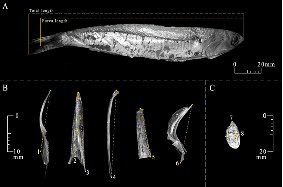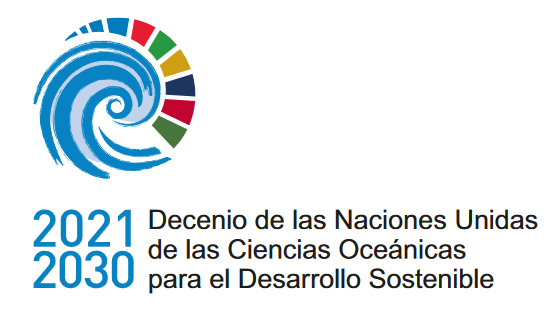Utilización de los huesos de la cabeza, cintura pectoral y otolitos para estimar la talla y el peso de la anchoíta (Engraulis anchoita), especie clave en el ecosistema marino patagónico
DOI:
https://doi.org/10.47193/mafis.3712024010103Palabras clave:
Huesos de la cabeza, otolitos, regresión, Patagonia, mediciones, talla-pesoResumen
La anchoíta, Engraulis anchoita, juega un papel vital como especie presa clave para varios depredadores marinos en el ecosistema marino patagónico norte del Océano Atlántico. Reconstruir la longitud y el peso de cada espécimen consumido es esencial para proporcionar una descripción detallada de la ecología trófica de los principales depredadores marinos. Se calcularon las ecuaciones de regresión lineal predictiva para el stock patagónico de anchoíta, a fin de estimar los parámetros de las relaciones talla-peso utilizando medidas de individuos completos y elementos de diagnóstico como otolitos, huesos de la cabeza y huesos de la aleta pectoral. Entre los elementos diagnósticos analizados, el cleitro y el dentario exhibieron el mejor ajuste. Este estudio valida el uso de los huesos de la cabeza y la cintura pectoral como indicadores confiables para predecir el peso y la talla de la anchoíta en un amplio rango de tamaños, que corresponden al rango objetivo de varios depredadores. Estas relaciones pueden contribuir a la determinación de la condición corporal, la estimación de la biomasa consumida y el cálculo de la densidad de energía, proporcionando información valiosa sobre la ecología trófica de los depredadores en el Océano Atlántico sur.
Descargas
Referencias
Belleggia M, Figueroa DE, Sánchez F, Bremec C. 2012. Long-term changes in the spiny dogfish (Squalus acanthias) trophic role in the southwestern Atlantic. Hydrobiologia. 684: 57-67. DOI: https://doi.org/10.1007/s10750-011-0967-y
Blacker R. 1974. Recent advances in otolith studies. In: Jones F, editor. Sea Fisheries Research. New York: Wiley.
Carlander KD, Smith LL. 1945. Some factors to consider in the choice between standard, fork, or total lengths in fishery investigations. Copeia. 1945: 7-12.
Carss DN, Elston DA. 1996. Errors associated with otter Lutra lutra faecal analysis. II. Estimating prey size distribution from bones recovered in spraints. J Zool. 238 (2): 319-332. DOI: https://doi.org/10.1111/j.1469-7998.1996.tb05397.x
Castillo J, Yorio P, Gatto A. 2019. Shared dietary niche between sexes in Magellanic Penguins. Austral Ecol. 44: 635-647. DOI: https://doi.org/10.1111/aec.12706
Ciancio JE, Bartes S, Fernández S, Harillo C, Lancelotti J. 2020. Energy density predictors for Argentine anchovy Engraulis anchoita, a key species of the southwestern Atlantic Ocean. Trans Am Fish Soc. 149: 204-212. DOI: https://doi.org/10.1002/tafs.10223
Ciancio JE, Yorio P, Buratti C, Colombo GÁ, Frere E. 2021. Isotopic niche plasticity in a marine top predator as indicator of a large marine ecosystem food web status. Ecol Indic. 126: 107687. DOI: https://doi.org/10.1016/j.ecolind.2021.107687
Crespo EA, Pedraza SN, Dans SL, Koen Alonso M, Reyes LM, García NA, Coscarella M, Schiavini ACM. 1997. Direct and indirect effects of the highseas fisheries on the marine mammal populations in the northern and central Patagonian coast. J Northw Atl Fish Sci. 22: 189-207. DOI: https://doi.org/10.2960/J.v22.a15
Fernández SJ, Yorio P, Ciancio JE. 2019. Diet composition of expanding breeding populations of the Magellanic Penguin. Mar Biol Res. 15: 84-96. DOI: https://doi.org/10.1080/17451000.2019.1596286
Fox J, Friendly GG, Graves S, Heiberger R, Monette G, Nilsson H, Ripley B, Weisberg S, Fox MJ, Suggests M. 2007. The car package. R Foundation for Statistical Computing. 1109: 1431.
Froese R. 2006. Cube law, condition factor and weight-length relationships: history, meta‐ analysis and recommendations. J Appl Ichthyol. 22: 241-253. DOI: https://doi.org/10.1111/j.1439-0426.2006.00805.x
Froese R, Tsikliras AC, Stergiou KI. 2011. Editorial note on weight-length relations of fishes. Acta Ichthyol Piscat. 41: 261-263. DOI: https://doi.org/10.3750/aip2011.41.4.01
Garciarena AD, Perrotta RG, López F. 2002. Informe sobre el muestreo de desembarque de anchoíta (Engraulis anchoita) y caballa (Scomber japonicus) en el puerto de Mar del Plata: período septiembre 1999-enero 2000, con algunos comentarios sobre el manejo de estos recursos. INIDEP Inf Téc. 45. 17 p.
Gatto AJ, Yorio P. 2009. Provisioning of mates and chicks by Cayenne and Royal Terns: resource partitioning in northern Patagonia, Argentina. Emu. 109: 49-55. DOI: https://doi.org/10.1071/MU08025
González-Zevallos D, Kuba L, Gosztonyi AE. 2010. Estimación de la longitud utilizando relaciones morfométricas de huesos del cráneo, cintura escapular, otolitos y medidas específicas del cuerpo en Merluccius hubbsi en aguas patagónicas. Rev Biol Mar Oceanogr. 45 (2): 341-345. DOI: https://doi.org/10.4067/S0718-19572010000200017
Gosztonyi AE, Kuba L. 1996. Atlas de los huesos craneales y de la cintura escapular de peces costeros patagónicos. Inf Téc Fund Patagon Nat. 4: 29 p.
Haimovici M, Velasco G. 2000. Relações comprimento peso de peixes teleósteos marinhos do sul do Brasil com uma avaliação de diferentes métodos de ajuste. Atlantica. 22: 131-140.
Hansel HC, Duke SD, Lofy PT, Gray GA. 1988. Use of diagnostic bones to identify and estimate original lengths of ingested prey fishes. Trans Am Fish Soc. 117: 55-62. DOI: https://doi.org/10.1577/1548-8659(1988)117<0055:UODBTI>2.3.CO;2
Hansen JE. 1997. Muestreo bioestadístico de pescado en el Puerto de Mar del Plata. Anchoíta (Engraulis anchoita). Período 1986-1990. Inf Téc INIDEP. 15: 1-24.
Hansen JE. 2004. Anchoíta (Engraulis anchoita). In: Sánchez RP, Bezzi SI, editors. El Mar Argentino y sus recursos pesqueros. Tomo 4. Los peces marinos de interés pesquero caracterización biológica y evaluación del estado de explotación. Mar del Plata: Instituto Nacional de Investigación y Desarrollo Pesquero (INIDEP). p. 101-115.
Hódar J. 1997. The use of regresion equations for the estimation of prey length and biomass in diet studies of insectivore vertebrates. Arx Misc Zool. 20: 1-10.
Ibarra C, Marinao C, Suárez N, Kasinsky T, Yorio P. 2022. Patterns of sexual segregation in the use of trophic resources in breeding Imperial Cormorants. Mar Biol. 169: 154. DOI: https://doi.org/10.1007/s00227-022-04143-7
Ibarra C, Marinao C, Suárez N, Yorio P. 2018. Differences between colonies and chick-rearing stages in Imperial Cormorant (Phalacrocorax atriceps) diet composition: implications for trophic studies and monitoring. Wilson J Ornithol. 130: 224-234. DOI: https://doi.org/10.1676/16-184.1
Koen Alonso M, Crespo E, García N, Pedraza S, Mariotti P, Vera BB, Mora N. 2001. Food habits of Dipturus chilensis (Pisces: Rajidae) off Patagonia, Argentina. ICES J Mar Sci. 58: 288-297. DOI: https://doi.org/10.1006/jmsc.2000.1010
Koen Alonso M, Crespo EA, García NA, Pedraza SN, Coscarella MA. 1998. Diet of dusky dolphins, Lagenorhynchus obscurus, in waters off Patagonia, Argentina. Fish Bull. 96: 366-374.
Koen Alonso M, Crespo EA, Pedraza SN, Garcia NA, Coscarella MA. 2000. Food habits of the South American sea lion, Otaria flavescens, off Patagonia, Argentina. Fish Bull. 98: 250-263.
Kuriakose S. 2017. Estimation of length weight relationship in fishes. Course Manual Summer School on advanced methods for fish stock assessment and fisheries management lecture note series no. 2/2017. CMFRI, Kochi, p. 215-220.
Laidig TE, Ralston S. 1995. The potential use of otolith characters in identifying larval rockfish (Sebastes spp.). Fish Bull. 93: 166-171.
Linhart H, Zucchini W. 1986. Model selection. New York: John Wiley & Sons.
Loizaga de Castro R, Saporiti F, Vales DG, García NA, Cardona L, Crespo EA. 2016. Feeding ecology of dusky dolphins Lagenorhynchus obscurus: evidence from stable isotopes. J Mammal. 97 (1): 310-320. DOI: https://doi.org/10.1093/jmammal/gyv180
Martínez‐Polanco MF, Béarez P, Jiménez‐Acosta M, Cooke RG. 2022. Allometry of Mexican hogfish (Bodianus diplotaenia) for predicting the body length of individuals from two pre‐Columbian sites in the Pearl Island archipelago (Panama). Int J Osteoarchaeol. 32: 669-681. DOI: https://doi.org/10.1002/oa.3094
Perez Comesaña J, Clavin P, Arias K, Riestra C. 2014. Total length estimation of the Brazilian flathead Percophis brasiliensis, using morphometric relationships of skull, pectoral girdle bones, otoliths and specific body measures, in Argentine waters. J Appl Ichthyol. 30: 377-380. DOI: https://doi.org/10.1111/jai.12244
Pirotta V, McIntosh R, Gray R, Marsh H, Lynch M. 2022. Marine mammals. In: Smith BP, Waudby CA, Hampton JO, editors. Wildlife Research in Australia: practical and applied methods. Clayton South: CSIRO Publishing. p. 465-477.
Prenda J, Granado-Lorencio C. 1992. Biometric analysis of some cyprinid bones of prey fishes to estimate the original lengths and weights. Folia Zool. 41: 175-185.
R Core Team. 2021. R: A language and environment for statistical computing. Vienna: R Foundation for Statistical Computing.
Ramos JA, Furness RW. 2022. Seabirds as indicators of forage fish stocks. In: Ramos J, Pereira L, editors. Seabird biodiversity and human activities. Boca Raton: CRC Press.
Riestra CM, Perez Comesaña JE, Arias KA, Tamini LL, Chiaramonte GE. 2020. Back-calculation of total length of Argentine seabass Acanthistius patachonicus using morphometric relationships of bones and measurements of the body. Mar Fish. 33: 69-75. DOI: https://doi.org/10.47193/mafis.3312020061804
Sánchez F. 2009. Alimentación de la merluza (Merluccius hubbsi) en el Golfo San Jorge y aguas adyacentes. INIDEP Inf Téc. 75. 21 p.
Scharf F, Yetter R, Sunninner A, Juanes F. 1998. Enhancing diet analyses of piscivorous fishes in the Northwest Atlantic through identification and reconstruction of original prey sizes from ingested remains. Fish Bull. 96: 575-588.
Schindelin J, Rueden CT, Hiner MC, Eliceiri KW. 2015. The ImageJ ecosystem: an open platform for biomedical image analysis. Mol Reprod Dev. 82: 518-529. DOI: https://doi.org/10.1002/mrd.22489
Sinovčić G, Franičević M, Zorica B, Čikeš‐ Keč V. 2004. Length-weight and length-length relationships for 10 pelagic fish species from the Adriatic Sea (Croatia). J Appl Ichthyol. 20: 156-158. DOI: https://doi.org/10.1046/j.1439-0426.2003.00519.x
Sokal R, Rohlf F. 1987. Biostatistics. 2nd ed. New York: Freeman. 301 p.
Tapella F, Lovrich GA. 2006. Morphological differences between ‘subrugosa’ and ‘gregaria’ morphs of adult Munida (Decapoda: Anomura: Galatheidae) from the Beagle Channel, southern South America. J Mar Biol Assoc UK. 86: 1149-1155. DOI: https://doi.org/10.1017/S0025315406014123
Velarde E, Ezcurra E, Anderson DW. 2013. Seabird diets provide early warning of sardine fishery declines in the Gulf of California. Sci Rep. 3: 1-6. DOI: https://doi.org/10.1038/srep01332
Velasco G, Castello JP. 2005. An ecotrophic model of southern Brazil continental shelf and fisheries scenarios for Engraulis anchoita (Pisces, Engraulididae). Atlantica. 27: 59-68.
Weatherley A, Gill H. 1987. The biology of fish growth. Orlando: Academic Press.

Descargas
Publicado
Número
Sección
Licencia
Derechos de autor 2024 Santiago J. Fernández, Cynthia Ibarra, Ximena Navoa, Javier E. Ciancio

Esta obra está bajo una licencia internacional Creative Commons Atribución-NoComercial-CompartirIgual 4.0.
Los autores de los artículos publicados en Marine and Fishery Sciences conservan los derechos de autor de sus artículos, a excepción de las imágenes de terceros y otros materiales añadidos por Marine and Fishery Sciences, que están sujetos a los derechos de autor de sus respectivos propietarios. Por lo tanto, los autores son libres de difundir y volver a publicar sus artículos, sujeto a los requisitos de los propietarios de derechos de autor de terceros y sujeto a que la publicación original sea completamente citada. Los visitantes también pueden descargar y reenviar artículos sujetos a los requisitos de citas. La capacidad de copiar, descargar, reenviar o distribuir cualquier material siempre está sujeta a los avisos de derechos de autor que se muestran. Los avisos de copyright deben mostrarse de manera prominente y no pueden borrarse, eliminarse u ocultarse, total o parcialmente. El autoalmacenamiento en servidores y repositorios de preimpresión está permitido para todas las versiones.
Esta revista ofrece a los autores una política de acceso abierto. Los usuarios pueden leer, descargar, copiar, distribuir, imprimir, buscar o vincular los textos completos de los artículos, o usarlos para cualquier otro propósito legal dentro de la licencia Creative Commons 4.0 (BY-NC-SA), sin solicitar permiso previo del editor o del autor. Esto está de acuerdo con la definición BOAI de acceso abierto.
 https://orcid.org/0000-0002-2805-0865
https://orcid.org/0000-0002-2805-0865
 https://orcid.org/0000-0003-1674-842X
https://orcid.org/0000-0003-1674-842X





















